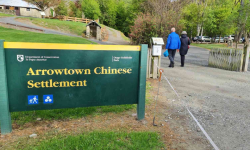
The Bible tells us about women who were disciples, leaders, teachers, prophets, and preachers. What can we learn from them? Sarah Harris considers some of the women who walked with Jesus.
Jesus had many disciples, but the group we most readily identify today are ‘the twelve’ who Jesus called and named apostles. This small group of disciples were all Jewish men, and so the church has sometimes drawn normative conclusions about the gender of Jesus’ disciples from this small group. (Interestingly the same conclusions are not drawn about their Jewish ethnicity.) As a result, we often fail to see the much wider group of Jesus’ disciples in the Gospels and forget the important roles they played. This article aims to highlight the women who followed Jesus, and to dispel the myth that disciples in the first century were exclusively men. It also seeks to show that there is not a discipleship hierarchy, where men are somewhere near the top of a mythical leadership ladder and women are close to the bottom. The final objective is to explain why there were twelve men whom Jesus called: These men (and all others) do matter, and it is important to acknowledge that!
Disciples are learners
A ‘disciple’ could equally be translated ‘learner,’ and in Jewish culture a disciple followed a rabbi (teacher). Rabbis were men, so the Hebrew and Aramaic word for a disciple was therefore masculine. Luke did make one exception when he called Tabitha a disciple using a feminine word in Acts 9: 36, but it appears that Luke may have coined this term and used it sparingly, as it was not a word in common currency (1). The clearest way to identify a first century disciple was not linguistic, but descriptive; we must look at what people were doing and saying. Meier notes the distinctives of Jesus’ disciples: He initiated the calling of his followers; these people followed him physically, therefore they left their homes; and they risked danger and hostility as they travelled with Jesus (2). As such, discipleship was not an exclusively male activity.
Women as disciples
Mary Magdalene, Joanna, and Susanna, who followed Jesus on his itinerant ministry, are three examples of female disciples (Luke 8:1-3).
Mary was the most common female name in the first century (3), and so a descriptor was added for clarification. Mary was from Magdala, or Migdal (Hebrew), and so she was Mary Magdalene. Magdala was a thriving city in the first century, and Mary must have been a woman with some level of social privilege as Luke tells us that she used her own wealth to provide for Jesus and the disciples as they travelled. She was someone who had been quite unwell, for Luke tells us that she had seven demons before Jesus healed her. It is likely she had been married, but with no husband in view, she was probably widowed or divorced. At this time, girls married at about age twelve to fourteen, so when she met Jesus she may not have been much older than twenty or thirty.
Let’s now look at Joanna: She was married to Herod’s steward Chuza (8:3). Anyone employed as a manager in Herod’s house would have lived with a reasonable level of wealth and privilege, so Joanna would have known some degree of social status. What is striking is that as a married woman, she left her husband to travel with a rabbi: Her discipleship was quite extraordinary.
Susanna is the third example of a female disciple, although Luke mentions that there were “many others” (8:3). We know nothing more of Susanna, though she also supported Jesus’ kingdom ministry out of her resources.
These women, however, do not enter the Gospel in three mere verses and then exit off the stage: They travelled with Jesus around Galilee and up to Jerusalem during the time of the passion, resurrection, and ascension. In this period, Jesus taught the male and female disciples and sent them into ministry contexts.
Mary of Bethany and her sister, Martha, are other named female disciples (Luke 10:38-42; John 11; 12:2). They called Jesus “The Teacher” (John 11:28) – an expression even the complementarian author Andreas Köstenberger acknowledges shows Jesus was their rabbi. He says: “The fact the expression is used here by a woman … is significant. Whereas contemporary rabbis regularly refused to instruct women, Jesus took a radically different approach.”(4) In Luke’s Gospel, Mary sat at Jesus’ feet as a learner (10:39): To sit in quietness and full submission is the posture of a disciple (see 1 Timothy 2:11).
A significant discipleship incident occurred when Jesus’ mother and brothers came to him (Matthew 12:46-50; Mark 3:31-35; Luke 8:19-21). Matthew tells us that someone said to Jesus, “your mother and your brothers are standing outside, wanting to speak to you.” Jesus, “pointing to his disciples” replied, “whoever does the will of my Father in heaven is my brother and sister and mother.” This positions discipleship around those carrying out God’s will. This is something that women frequently exemplify.
Women as leaders
The first theologian in Luke’s Gospel was a woman – Mary, the motheru2028of Jesus. She had clear theological interest and her articulation of praise to God has been formative for the church because of its depth and clarity (Luke 1:46-55). Synagogue and family prayers were filled with cycles of Scripture reading which aided a person’s knowledge of God and supported a theocentric worldview. Women were participants and visible in synagogue life in the first century: The crippled woman was in the synagogue when Jesus called and healed her (Luke 13:10-17). Yet the synagogue was a place in which women not only participated – some became leaders. Vamosh notes that: “written sources, including tomb inscriptions … attest to women’s leadership roles. Their attendance in synagogue was a given.” (5)
Women learned about God in places other than ‘religious spaces.’ They were present at the dinner table where theological and philosophical discussion often occurred: The Bethany house is one example (John 12:1-8) and Jesus was often aroundu2028a meal table – we can see this in the Gospels. The Roman bath house was also a place where symposia were held and learning occurred. These were found throughout the Empire, including Palestine: In the large bath house in Beit She’an there is a Christian cross in one of the porticoes showing that this was part of a believer’s life. As a result, it should not be surprising to find that some women became teachers. Anna is one such example (6). Luke 2:36-38 tells how she habitually spoke of God’s coming redemption to all who were in the temple. This was not a one-off activity, signalled by the knowledge that she “never left the temple” (2:37) and the present continuous language of speaking in 2:38. Anna was a recognised prophet for Israel in the time of Jesus. She stood in a significant line of Old Testament female prophets from Miriam, through Deborah, Noadiah, and Huldah, and she was the first of the eschatological prophetesses described in Joel and at Pentecost (7).
Jesus’ crucifixion was one very significant place where women were found. In fact, we could say the women exhibited a loyalty to Jesus which stands in contrast to Peter who denied the Lord (Matthew 25:69-75; Mark 14:66-72; Luke 22:54-62; John 18:15-18, 25-27). These women were also involved at the time of Jesus’ burial and they were first to hear the news of Jesus’ resurrection. Mark, the first Gospel written, tells us how the women were commanded to go and tell the men what had happened (16:7), and his narrative finishes with the women and their actions. Matthew’s Gospel is similar but the women’s role is more intense: They were commanded to go and proclaim the news to the men (28:10): They were divinely commissioned as proclaimers – preaching language! In Luke’s narrative, the astonished women go to tell the men what had happened. Notably, the women exhibited faith while the men did not (24:10-11).
We sometimes forget that Jesus appeared to the disciples again (Luke 24:36). He opened their minds to understand the scriptures, commissioned them to be filled with the Spirit and to proclaim the gospel (24:45-47; Acts 1:8), and blessed them at the ascension (24:50).
The women never exited the stage! They were a part of the early worshipping community (Acts 1:14) and present at Pentecost (Acts 2:1-39). Women were integral to Jesus’ discipleship team; it never was purely a one-gender group.
Yet Jesus did choose twelve Jewish men and their centrality to the wider story of Scripture is important. So what can we say of their role?
The twelve male disciples
The twelve had a particular role to play in the story of Jesus, but they also have a part that is yet to come: Luke explains that they have an eschatological role when they will judge the twelve Jewish tribes (22:30). (This is why they were Jewish and not Gentile men.) The twelve represent the culmination of the story of Israel (what has been in the past), and in that sense they fulfil the place of the twelve tribes. But the role of a disciple moved quickly to cross gender, ethnic, and social boundaries. By the time John’s Gospel was written in about the 90’s, the twelve were known but they are only mentioned twice. I suggest that by this time it was clear that discipleship was not about these men, it was about a role that many played including Mary and Martha who feature strongly in the Fourth Gospel. This is confirmed in the book of Acts where women such as Lydia and Priscilla also feature prominently. In fact, Priscilla and her husband, Aquila, are often referred to as “the most prominent couple involved in the first-century expansion of Christianity,” (8) and their wake is significant. This story (and that of Lydia) deserves more space than this article can allow, but suffice to say that this couple knew the scriptures more fully than Apollos (a key Christian leader), were teachers in the church at Ephesus, and explained Christological truth to this man. Priscilla and Aquila (yes she is mentioned first, defying cultural custom) are presented as gifted and godly teachers who were of high standing. In many ways Priscilla epitomises the significance to which women in the early church rose, which I find very exciting.
I trust that when you pick up the Bible, your eyes will be increasingly enlightened to the work of God in and by both women and men. The mission imperative can only be fulfilled as each take their part and use their gifts to grow and build up the people of God, for God is sending all into the world.
Story: Dr Sarah Harris
Sarah is a New Testament lecturer at Carey Baptist College.
Take Outs
- What does your discipleship look like? Are there things that you would like to see change? u2028
- What is your view on women as disciples? What is your view on women as leaders in the church? u2028
- Does this article challenge any of your thinking? What could you do to explore and address this? u2028
References:
1. John P. Meier, A Marginal Jew: Rethinking the Historical Jesus, vol. 3 (New York: Doubleday, 2001), 78-80; Jacqui Lloyd, “The Women Who Followed Jesus,” Stimulus 20 (2013): 8-9.
2. Meier, 47-73.
3. Richard Bauckham, Jesus and the Eyewitnesses: The Gospel as Eyewitness Testimony (Grand Rapids: Eerdmans, 2006), 89.
4. Andreas Köstenberger, John, BECNT (Grand Rapids: Baker Academic, 2004), 337.
5. Miriam Feinberg Vamosh, Women at the Time of the Bible (Herzlia: Palphot, 2007), 93.
6. Sarah Harris, “Letting (H)Anna Speak: An Intertextual Reading of the New Testament Prophetess,” Feminist Theology (2017) forthcoming.
7. Turid Karlsen Seim, The Double Message: Patterns of Gender in Luke-Acts (London: T & T Clark, 1990), 177.
8. Greg W. Forbes and Scott D. Harrower, Raised from Obscurity: A Narratival and Theological Study of the Characterization of Women in Luke-Acts (Eugene: Pickwick, 2015), 193.
Scripture: Unless otherwise specified, Scripture quotations are from New Revised Standard Version Bible, copyright © 1989 National Council of the Churches of Christ in the United States of America. Used by permission. All rights reserved.


